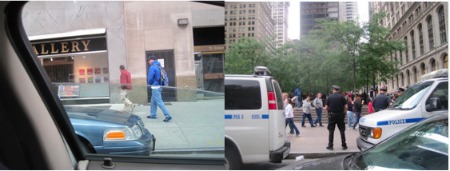Infiltration to Disrupt, Divide and Misdirect Is Widespread in Occupy
In its first five months, the Occupy movement has had major victories and has altered the debate about the economy. People in the power structure and who hold different political views are pushing back with a traditional tool -- infiltration. Across the country, Occupies are struggling with disruption and division.
By Kevin Zeese and Margaret FlowersEditor’s note: An earlier version of this article contained erroneous information about an alleged infiltrator, identified as Michael Stack, who the article said provoked people in the Occupy movement in Washington, D.C., and New York to resist police with force. There was such a person at the Occupy protests, but the authors have informed us that it was not Michael Stack. The article has been edited to correct that error.
This is Part I of a two-part series on infiltration of Occupy and what the movement can do to limit damage by those who seek to cause harm from within. This article describes public reports of infiltration as well as results of a survey and discussions with Occupiers about the issue. The second article will examine the history of political infiltration and steps the movement can take to address it.
In its first five months, the Occupy movement has had major victories and has altered the debate about the economy. People in the power structure and who hold different political views are pushing back with a traditional tool — infiltration. Across the country, Occupies are struggling with disruption and division, attacks on key people, escalation of tactics to include property damage and police conflict as well as misuse of websites and social media.
As Part II of this discussion will show, infiltration is the norm in political movements in the United States. Occupy has many opponents likely to infiltrate to divide and destroy it beyond the usual law enforcement apparatus. Other detractors include the corporations whose rule Occupy seeks to end; conservative right-wing groups allied with corporate interests; and members of the power structure including nonprofit organizations linked with corporate-funded political parties, especially the Democratic Party, which would like Occupy to be its tea party rather than an independent movement critical of both parties.
On the very first day of the Occupation of Wall Street, we saw infiltration by the police. We were leaving Zuccotti Park and stopped in traffic. We saw the doors of an unmarked van open and in the front seat were two uniformed police officers. Out of the back came two men wearing backpacks, sweatshirts and jeans. They walked into Zuccotti Park and became part of the crowd.
In the first week of the Occupation of Freedom Plaza in Washington, D.C., we saw the impact of right-wing infiltration. A peaceful protest was planned at the drone exhibit at the Smithsonian Institution. The plan was for a banner drop and a “die-in” under the drones. But as protesters arrived at the museum, two people ran out in front, threatening the security guards and causing them to pepper-spray protesters and tourists. One of the “protesters” was Patrick Howley, an assistant editor at The American Spectator, wrote a column bragging about his role as an agent provocateur.
There have been a handful of other reports of infiltration around the country. In Oakland, CopWatch filmed an Oakland police officer infiltrating.
In another video, CopWatch includes audiotape of Oakland’s newly appointed police chief, Howard Jordan, talking about how police departments all over the country infiltrate, not just to monitor protesters but to manipulate and direct them.
There were also reports in Los Angeles of a dozen undercover police being in the L.A. encampment before Occupiers were forcibly evicted by the authorities. The raid by the L.A. police was brutal and resulted in mass arrests. Some of those arrested were mistreated in jails. Most of the charges were dropped. Similar pre-raid undercover activities were reported in Nashville, Tenn.
The Los Angeles encampment also had infiltrators from the right-wing group Free Republic, which posted on its Web page a call for infiltrators to block a vote concerning an offer from the city of Los Angeles for virtually free space for Occupy L.A.: “Need LA Freepers to show up to block this vote by the Occupy L.A. General Assembly. How brave are you?” In the end, L.A. Occupy decided not to accept the offer from the city, a decision opposed by some in the encampment.
In New York, there were also reports of infiltration. For example, one protester described how undercover agents infiltrated a demonstration at Citibank and were the loudest and most disruptive participants. The protester, after listening to conversations later at a police station, said in an interview: “It was a bit startling how ‘inside’ their information was, how they [undercover agents] were being paid to go to these protests and put us in situations where we’d be arrested and not be able to leave.”
Survey and Interviews of Occupiers Show Common Tactics and Infiltrators
These scattered reports seem to be the tip of the iceberg. As a result of experiencing extreme divisive tactics and character assassination on Freedom Plaza, we began to hear from Occupiers across the country about similar incidents in their encampments. We decided to survey people about infiltration.Recently we toured occupations on the West Coast, where we spoke to many participants, and have attended General Assemblies at Occupy Wall Street and Philadelphia. We heard stories in Arizona of someone with website administrative privileges deleting the live-stream archive that included video that was to be used in defense of some who were arrested. In Lancaster, Pa., someone took control of the email list, making it an announce-only list, and when the police threatened to close the camp, that person put out a statement that the Lancaster Occupiers had decided to go without any conflict. In fact, no such decision had been made and 30 Occupiers had planned to risk arrest when the police tried to remove them. The false email resulted in no resistance.
Our West Coast trip ended at the Occupy Olympia Solidarity Social Forum. We were able to survey 41 people representing 15 occupations primarily on the West Coast but including Missoula, Mont., and New Orleans. Participants were questioned about 10 behaviors. The most common behaviors, seen in roughly two-thirds of those surveyed and covering 12 of the 15 occupations, were:
1. Disruptions of the General Assemblies and attempts to divide the group. Individuals would interrupt General Assemblies with emergency items or sidetrack the agenda with their personal needs or issues. When proposals were presented to the General Assembly on principles for the occupation or plans to prevent division, individuals would question the authority of the writers of the proposal, launch personal attacks or question their abilities. There were frequent attacks on people who did the most work and were perceived as leaders. The anti-leadership views of many Occupiers were used to essentially attack the most effective people. Sue Basko wrote about this in a comment in Truthdig on a Chris Hedges article in Truthdig. There was an “ongoing campaign of harassment and coercion against the Occupy L.A. participants and volunteers,” Basko wrote. “Each day is a fresh set of victims.” She described the use of Twitter, Listservs and blogs to “defame and harass anyone giving their efforts to help Occupy L.A.” This included attacks on “social media workers, the website team, the lawyers (including me), the medics, the live streamers, the writers and on and on,” she said. She also wrote that “there is the very strong belief that some among them are FBI or DHS [Department of Homeland Security] agents placed there to start the group, egg it on, control it.” Conversations with others in Los Angeles confirmed this report. Our experience in suffering personal attacks included outlandish lies calling us criminals and thieves and near daily email attacks since early December. We found that when we respond and correct lies, it does not stop them and have concluded that if someone has the intention to be a character assassin there is nothing you can do except expose them. Although that may not stop them, it at least gets those in the occupation who are not gullible to doubt the undocumented personal attacks.
2. Individuals who took over the website and/or social media and then removed them or hacked them and took control. As noted above, these networks have been used in personal attacks, as well as to send inaccurate messages to the media and other Occupiers. One mistake is to allow a large number of people to have administrative privileges on the website. Being an administrator allows that person to erase crucial information, as occurred in Phoenix. In Washington, D.C., we have been removed as administrators of a Facebook page we created because we allowed people who turned out to be untrustworthy to have administrative privileges. People can blog or post to Facebook or websites without being administrators.
Division over how money was being spent was an issue reported by 50 percent of respondents, and in 12 out of 15 occupations individuals persistently raised questions about transparency and the use of funds. In General Assemblies in New York and Philadelphia, we saw disruption by people who complained about money issues. In New York, an argument about access to free MetroCards resulted in a 30-minute argument. In Philadelphia, there was a vague complaint centering on the question “Where is the money?” We saw something similar at a 99 percent’s meeting in San Francisco where one of the questioners complained about supposedly missing money. And we have seen still more situations of this kind in Washington, D.C. Sometimes these disrupters seem like homeless or emotionally disturbed individuals. They could be acting out their concerns or they could be encouraged by police to attend meetings to cause disruption and may be paid a small amount to do so. Whether paid or not, the impact is the same — it takes the Occupy off its political agenda and turns people off to participating in the movement.
Finally, the issue of escalation of tactics to include property damage and conflict with police was brought up. The euphemism for this is “diversity of tactics.” In fact, there is great diversity within nonviolent tactics. A strong debate exists between those who favor strategic nonviolence and those who favor property destruction and police conflict. In 11 of 15 occupations, there were reports of verbal attacks on police and/or escalation of tactics from nonviolence to property destruction or violence. In one occupation, an individual took over the direct action working group and escalated the tactics used beyond what the group had agreed upon. In another Occupy, the General Assembly approved putting up a structure but agreed that if the police wanted it taken down the protesters would promptly do so to prove that it was temporary. After the structure was put up, a handful of people refused to take it down, causing a 10-hour police conflict and undermining public support for the Occupy. In another occupation, because a minority of the demonstrators refused to adopt nonviolent strategies, a protest with the teachers union was canceled, preventing a major opportunity to expand the movement. When it comes to the issue of violence versus property damage, it is particularly hard to tell whether the differences are political or instigated by infiltrators.Participants were asked about attempts at co-optation by law enforcement, individuals or organizations affiliated with the Democratic Party and about suspected infiltration by right-wing groups. Eight of the 15 occupations (41 percent of respondents) reported Democratic groups attempted to co-opt them, using the demonstrations to push or prevent a legislative agenda or using their social media to change the times of protests or meetings. Far fewer reported suspicion or evidence of right-wing infiltration (12 percent of respondents in four occupations), most stating that the corporate media provided poor or misleading coverage. The most common form of infiltration was by law enforcement agencies (49 percent of respondents, 11 of 15 occupations). Some respondents reported having video evidence; some reported law enforcement officers having more information than they had been given — such as police using names of Occupiers when names had never been provided; and some suspected police infiltration but had no proof.
Of course, there is a lot of suspicion, but people are rarely able to prove infiltration. These incidents could be the work of people with real political disagreement within the Occupy, or the work of people who are emotionally disturbed or mentally ill or who bring other personal challenges with them. Or, the incidents could be the result of infiltrators manipulating such people, playing on their fears and prejudices. This is not a simple issue, as we will discuss in Part II. It is best to judge people by their actions and not label them as infiltrators without direct proof.
Some may wonder why Democrats or groups closely affiliated with the Democrats, such as MoveOn.org, Campaign for America’s Future, Rebuild the Dream or unions like the SEIU, would want to infiltrate the Occupy. (Note: Individuals who are Democrats or members of a union, MoveOn or other groups are not the same as the leadership.) Essentially, leaders of these groups see Occupy as the Democrats’ potential answer to the tea party. Occupiers do not see themselves that way, but these groups want the movement to adopt their strategy of working within the Democratic Party. In one example, Eric Lotke, a senior policy analyst for SEIU who has been involved in Occupy D.C., appeared on a radio show with two other Occupiers from the Washington, D.C., and Oakland demonstrations. Lotke said he was speaking as an Occupier from D.C. and talked about “taking back Congress in 2012” and the need for an electoral strategy and gave the usual Democratic rhetoric about President Obama needing more time. The two other guests said Lotke was completely out of step with most Occupiers, who say we should not focus on electoral politics but instead should build an independent movement to challenge the corrupt system. We doubt the Occupy D.C. General Assembly members agreed with Lotke’s pro-Democratic Party, pro-Obama views, but he had positioned himself to speak for them. Van Jones of Rebuild the Dream similarly was appearing in the media as if he were an Occupy spokesperson, claiming there will be 2,000 “99 percent candidates” in 2012, again trying to push Occupy into Democratic electoral politics. These are just two examples of many Democratic Party operatives trying to drag Occupy into their politics despite the movement consistently describing itself as independent and non-electoral.
We have seen some Occupiers attacking the National Occupation of Washington, DC, scheduled to begin March 30, while other Occupiers have shown enthusiasm for it. Solidarity with NOW DC has been shown by 19 General Assemblies of occupations around the country. InterOccupy classifies it as a national event. The attackers have been criticizing NOW DC by finding fault with the authors of this article. This criticism is occurring at the same time that Democratic Party-aligned groups have announced their own project — “99%’s Spring” — that will take place at the same time as NOW DC. Thus far the dividers have succeeded in preventing solidarity between the two D.C. occupations and the rest of the Occupy movement. Is the timing a coincidence?
No doubt the information in this article is incomplete. We have been able to survey and talk with people at only about 20 Occupies. We would very much like to hear from others about experiences at their occupation, as understanding these tactics is the first step in confronting and addressing them. (Send your comments to [email protected].)
In Part II of this series, we will focus on the history of government infiltration and the destruction of political movements and political leaders. We will also examine steps that can be taken to minimize the damage from these tactics. One thing evident from the history: Infiltration has been common in political movements for centuries, as have divisive methods, attacks on leaders, escalation of tactics, fights over money and misinformation disseminated to the public.
Margaret Flowers and Kevin Zeese were among the original organizers of Occupy Washington, DC, and are now helping with the National Occupation of Washington, DC.
Your support matters…Independent journalism is under threat and overshadowed by heavily funded mainstream media.
You can help level the playing field. Become a member.
Your tax-deductible contribution keeps us digging beneath the headlines to give you thought-provoking, investigative reporting and analysis that unearths what's really happening- without compromise.
Give today to support our courageous, independent journalists.
 Two men believed to be undercover police officers who just stepped out of a police van (left) and an officer in blue entering Zuccotti Park (right). Photos by Margaret Flowers.
Two men believed to be undercover police officers who just stepped out of a police van (left) and an officer in blue entering Zuccotti Park (right). Photos by Margaret Flowers.





You need to be a supporter to comment.
There are currently no responses to this article.
Be the first to respond.